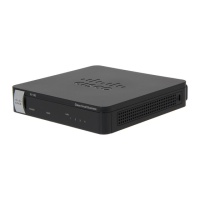Configuring Virtual Private Networks (VPNs) and Security
Configuring Security
Cisco RV180/RV180W Administration Guide 122
5
A self certificate is a certificate issued by a CA identifying your device (or self-
signed if you don't want the identity protection of a CA). To request a self
certificate to be signed by a CA, you can generate a Certificate Signing Request
from the gateway by entering identification parameters and sending to the CA for
signing. Once signed, the CA's Trusted Certificate and signed certificate from the
CA are uploaded to activate the self-certificate validating the identity of this
gateway. The self certificate is then used in IPsec and SSL connections with peers
to validate the gateway's authenticity.
To configure certificates, choose Security > SSL Certificate. You can choose the
following options:
• Trusted Certificates—Upload a certificate from a trusted authority (for
example, a certificate Authority such as Microsoft or VeriSign). See
Uploading a Trusted Certificate.
• Self Certificates—Upload a certificate that has been generated from the
Cisco RV180/RV180W, and either signed by a CA, or self-signed. See
Uploading a Self Certificate.
• Self Certificate Requests—Generate a self-certificate request to give to a
CA for signing, or to self-certify. See Generating New Certificate
Requests.
• Export Router Certificate—Export a router certificate to give to clients who
want to connect to the router and use the certificate for authentication. See
Exporting the Router’s Current Certificate.
Uploading a Trusted Certificate
If you have a certificate from a trusted authority to upload, the file must be located
on the computer connected to the Cisco RV180/RV180W. Perform the following
steps:
STEP 1 Choose Security > SSL Certificate.
STEP 2 In the Trusted Certificates (CA Certificate) Table, click Upload.
STEP 3 Click Browse and locate the file on your computer.
STEP 4 Click Upload. The new certificate appears in the table.

